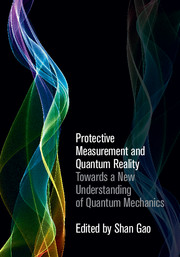Book contents
- Frontmatter
- Dedication
- Contents
- List of Contributors
- Preface
- Acknowledgements
- 1 Protective measurement: an introduction
- Part I Fundamentals and applications
- 2 Protective measurement of the wave function of a single system
- 3 Protective measurement, postselection and the Heisenberg representation
- 4 Protective and state measurement: a review
- 5 Determination of the stationary basis from protective measurement on a single system
- 6 Weak measurement, the energy–momentum tensor and the Bohm approach
- Part II Meanings and implications
- Index
- References
5 - Determination of the stationary basis from protective measurement on a single system
from Part I - Fundamentals and applications
Published online by Cambridge University Press: 05 January 2015
- Frontmatter
- Dedication
- Contents
- List of Contributors
- Preface
- Acknowledgements
- 1 Protective measurement: an introduction
- Part I Fundamentals and applications
- 2 Protective measurement of the wave function of a single system
- 3 Protective measurement, postselection and the Heisenberg representation
- 4 Protective and state measurement: a review
- 5 Determination of the stationary basis from protective measurement on a single system
- 6 Weak measurement, the energy–momentum tensor and the Bohm approach
- Part II Meanings and implications
- Index
- References
Summary
We generalize protective measurement for protective joint measurement of several observables. The merit of joint protective measurement is the determination of the eigenstates of an unknown Hamiltonian rather than the determination of features of an unknown quantum state. As an example, we precisely determine the two eigenstates of an unknown Hamiltonian by a single joint protective measurement of the three Pauli matrices on a qubit state.
Introduction
Protective measurement is one of the unexpected consequences of the strange structure of quantum mechanics. According to general wisdom, we cannot gain information on the unknown state ρ of a single quantum system unless we distort the state itself. In particular, we cannot learn the unknown state of a single system whatever test we apply to it. It came as a surprise that in weak measurements [1] the expectation value 〈Â〉 of an observable  can be tested on a large ensemble of identically prepared unknown states in such a way that the distortions per single systems stay arbitrarily small (see [2], too). An indirectly related surprise came with the so-called protective measurements [3, 4, 5] capable of testing 〈Â〉 at least in an unknown eigenstate of the Hamiltonian Ĥ at arbitrarily small distortion of the state itself. Interesting debates followed the proposal as to the merit of protective measurement in the interpretation of the wave function of a single system instead of a statistical ensemble (see, e.g., [6] and references therein).
My work investigates an alternative merit of protective measurement. First I construct joint protective measurements of several observables Â1, Â2, … and re-state the original equations for them in a general form. Then I show that the straightforward task that a single joint protective measurement solves on a single system is the determination of the eigenstates of an otherwise unknown Hamiltonian.
- Type
- Chapter
- Information
- Protective Measurement and Quantum RealityTowards a New Understanding of Quantum Mechanics, pp. 63 - 67Publisher: Cambridge University PressPrint publication year: 2015
References
- 1
- Cited by



